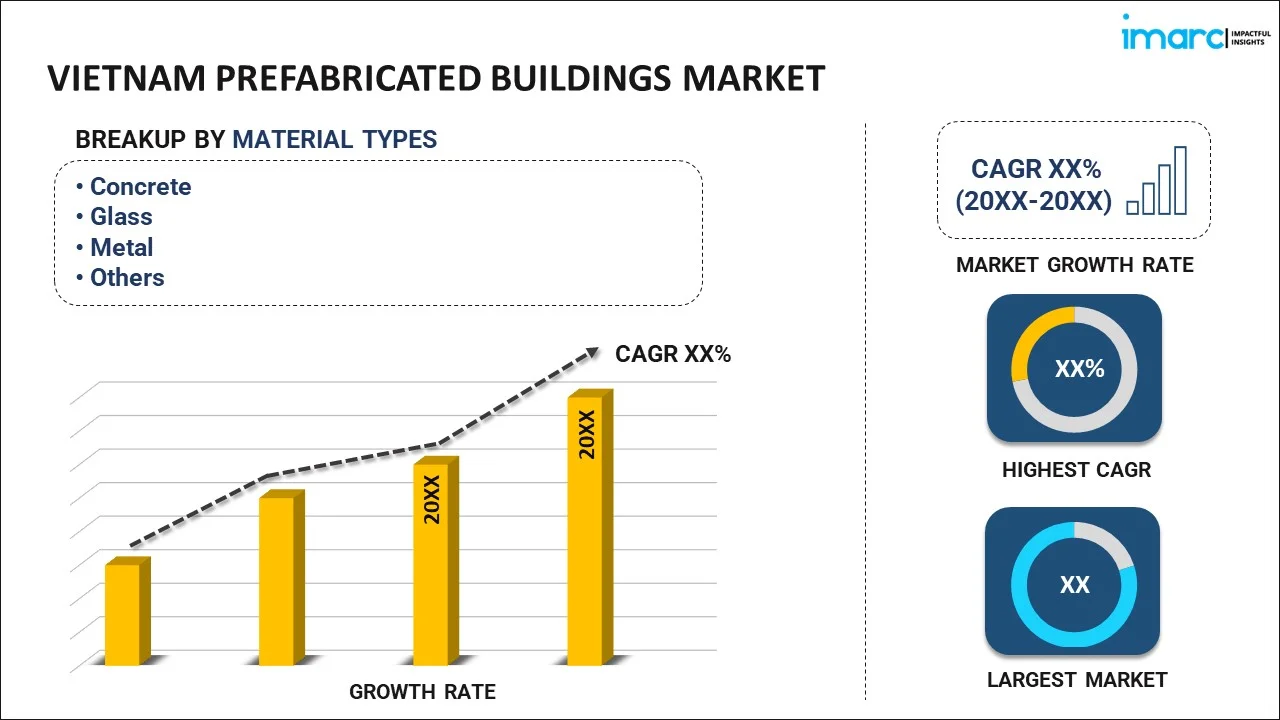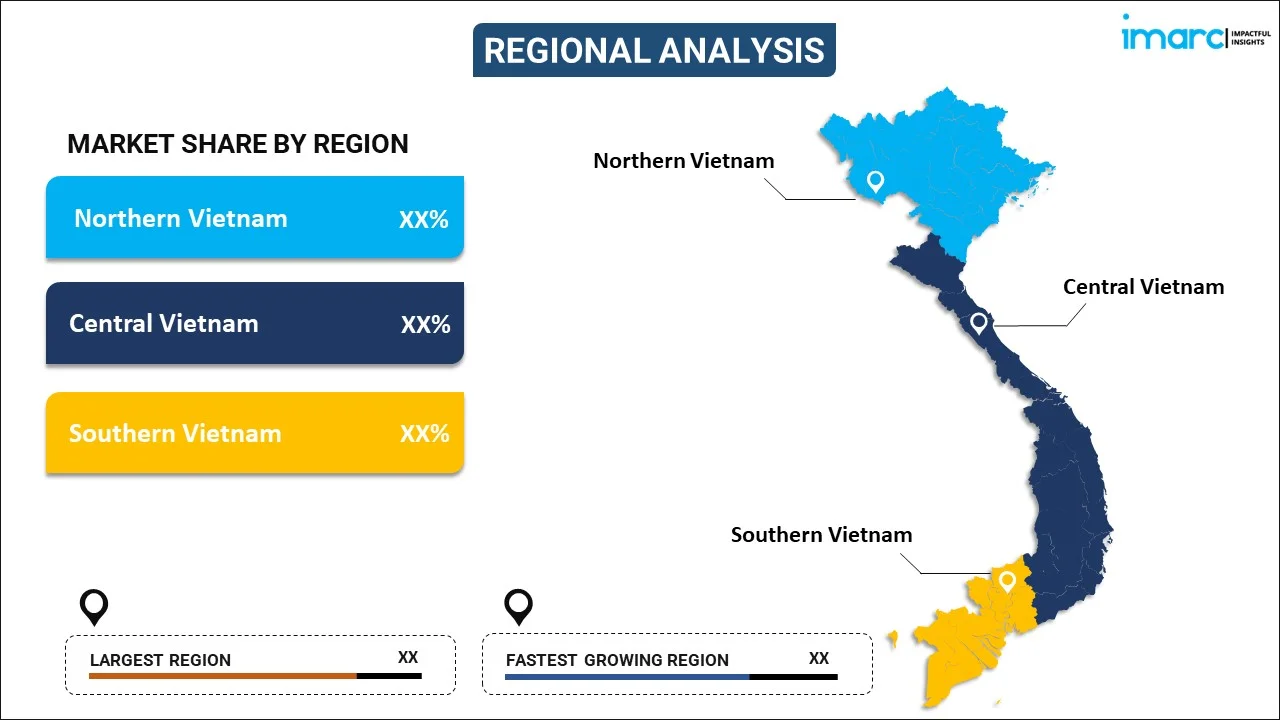
Vietnam Prefabricated Buildings Market Report by Material Type (Concrete, Glass, Metal, Timber, and Others), Application (Residential, Commercial, and Others), and Region 2024-2032
Market Overview:
Vietnam prefabricated buildings market is projected to exhibit a growth rate (CAGR) of 3.6% during 2024-2032. Expanding urbanization, booming real estate sector, increased construction efficiency, cost-effectiveness, shorter construction timelines, demand for quality control, and favorable government initiatives represent some of the key factors driving the market.
|
Report Attribute
|
Key Statistics
|
|---|---|
|
Base Year
|
2023 |
|
Forecast Years
|
2024-2032
|
|
Historical Years
|
2018-2023
|
| Market Growth Rate (2024-2032) | 3.6% |
Prefabricated buildings are structures whose components are manufactured in a factory setting before being transported and assembled on-site. It comprises of various materials such as steel, wood, or concrete, and prefabricated buildings are designed for durability and high performance. These buildings are made up of pre-engineered components, such as walls, floors, roofs, and modules, that are designed to fit together seamlessly, like pieces of a puzzle, during on-site construction. They also find applications across a wide range of sectors, including residential, commercial, and industrial, fulfilling needs from simple storage spaces to complex, multi-story structures. The customization capabilities, combined with reduced labor costs and construction times, make prefabricated buildings an attractive alternative. As compared to traditional construction methods, prefabricated buildings offer a quick, efficient, and cost-effective building project. Besides this, they offer numerous benefits such as energy efficiency and reduced waste, aligning with the growing emphasis on sustainable construction practices.
Vietnam Prefabricated Buildings Market Trends:
One of the prime drivers fueling the market growth is the country's booming real estate sector, with increasing urbanization and a rising middle-class population, which is creating a heightened demand for residential and commercial spaces. Besides this, the Vietnamese government is investing heavily in infrastructure development, further propelling the need for rapid, efficient construction practices, including the use of prefabricated buildings. Moreover, Vietnam is becoming a manufacturing hub, leading to an uptick in demand for industrial spaces, another sector where prefabrication has advantages. In confluence with this, the versatility of prefabricated buildings, extending their usage in a multitude of settings, from residential and office buildings to healthcare facilities and educational institutions also contributes to the market growth. Concurrently, ongoing technological advancements in prefabrication methods and materials enhancing the structural integrity and lifespan of these buildings, are presenting lucrative opportunities for market expansion. In line with this, the growing focus on sustainability and environmental consciousness in construction practices urging the adoption of materials and technologies that minimize waste and energy consumption, are propelling the popularity of prefabricated buildings. Additionally, the market is benefiting from the positive economic indicators and increasing foreign direct investments (FDI) in the country, which are boosting industrial and commercial activities. Along with this, Vietnam is prone to natural disasters, such as typhoons and flooding, which is driving the need for prefabricated buildings to offer a quick and efficient way to provide shelter and facilities in the aftermath of such disasters. Furthermore, prefabricated buildings often require fewer labor hours compared to traditional construction, leading to reduced labor costs and shorter project timelines, thereby contributing to market growth. Apart from this, prefabricated buildings offer a high degree of design flexibility, enabling architects to create aesthetically pleasing and innovative structures which is strengthening the market growth.
Vietnam Prefabricated Buildings Market Segmentation:
IMARC Group provides an analysis of the key trends in each segment of the market, along with forecasts at the country level for 2024-2032. Our report has categorized the market based on material type and application.
Material Type Insights:

- Concrete
- Glass
- Metal
- Timber
- Others
The report has provided a detailed breakup and analysis of the market based on the material type. This includes concrete, glass, metal, timber, and others.
Application Insights:
- Residential
- Commercial
- Others
A detailed breakup and analysis of the market based on the application have also been provided in the report. This includes residential, commercial, and others.
Regional Insights:

- Northern Vietnam
- Central Vietnam
- Southern Vietnam
The report has also provided a comprehensive analysis of all the major regional markets, which include Northern Vietnam, Central Vietnam, and Southern Vietnam.
Competitive Landscape:
The market research report has also provided a comprehensive analysis of the competitive landscape in the market. Competitive analysis such as market structure, key player positioning, top winning strategies, competitive dashboard, and company evaluation quadrant has been covered in the report. Also, detailed profiles of all major companies have been provided.
Vietnam Prefabricated Buildings Market Report Coverage:
| Report Features | Details |
|---|---|
| Base Year of the Analysis | 2023 |
| Historical Period | 2018-2023 |
| Forecast Period | 2024-2032 |
| Units | US$ Billion |
| Scope of the Report | Exploration of Historical Trends and Market Outlook, Industry Catalysts and Challenges, Segment-Wise Historical and Predictive Market Assessment:
|
| Material Types Covered | Concrete, Glass, Metal, Timber, Others |
| Applications Covered | Residential, Commercial, Others |
| Regions Covered | Northern Vietnam, Central Vietnam, Southern Vietnam |
| Customization Scope | 10% Free Customization |
| Report Price and Purchase Option | Single User License: US$ 3699 Five User License: US$ 4699 Corporate License: US$ 5699 |
| Post-Sale Analyst Support | 10-12 Weeks |
| Delivery Format | PDF and Excel through Email (We can also provide the editable version of the report in PPT/Word format on special request) |
Key Questions Answered in This Report:
- How has the Vietnam prefabricated buildings market performed so far and how will it perform in the coming years?
- What has been the impact of COVID-19 on the Vietnam prefabricated buildings market?
- What is the breakup of the Vietnam prefabricated buildings market on the basis of material type?
- What is the breakup of the Vietnam prefabricated buildings market on the basis of application?
- What are the various stages in the value chain of the Vietnam prefabricated buildings market?
- What are the key driving factors and challenges in the Vietnam prefabricated buildings?
- What is the structure of the Vietnam prefabricated buildings market and who are the key players?
- What is the degree of competition in the Vietnam prefabricated buildings market?
Key Benefits for Stakeholders:
- IMARC’s industry report offers a comprehensive quantitative analysis of various market segments, historical and current market trends, market forecasts, and dynamics of the Vietnam prefabricated buildings market from 2018-2032.
- The research report provides the latest information on the market drivers, challenges, and opportunities in the Vietnam prefabricated buildings market.
- Porter's five forces analysis assist stakeholders in assessing the impact of new entrants, competitive rivalry, supplier power, buyer power, and the threat of substitution. It helps stakeholders to analyze the level of competition within the Vietnam prefabricated buildings industry and its attractiveness.
- Competitive landscape allows stakeholders to understand their competitive environment and provides an insight into the current positions of key players in the market.
Need more help?
- Speak to our experienced analysts for insights on the current market scenarios.
- Include additional segments and countries to customize the report as per your requirement.
- Gain an unparalleled competitive advantage in your domain by understanding how to utilize the report and positively impacting your operations and revenue.
- For further assistance, please connect with our analysts.
 Inquire Before Buying
Inquire Before Buying
 Speak to an Analyst
Speak to an Analyst
 Request Brochure
Request Brochure
 Request Customization
Request Customization




.webp)




.webp)












